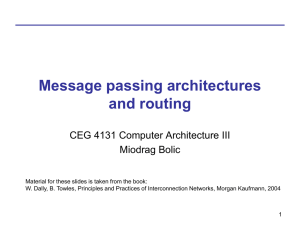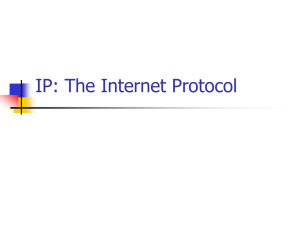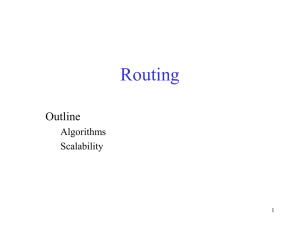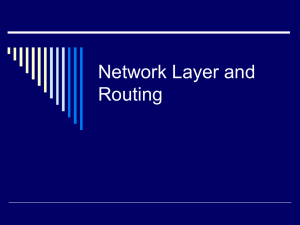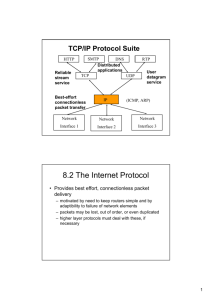IP Routing
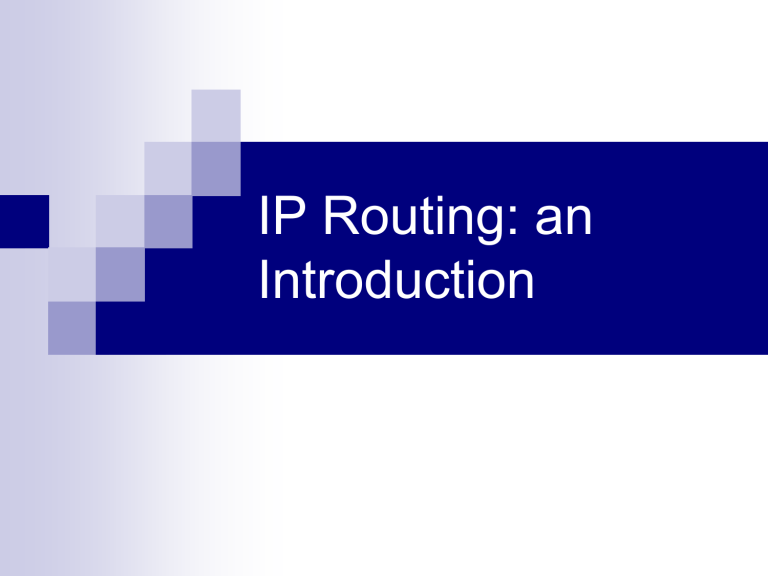
IP Routing: an
Introduction
Quiz
0-31
32-63
64-95
96-127
128-159
160-191
192-223
224-255
Routing
IP routing is the process of moving packets from one network to another network using routers
A routing protocol is a tool used by routers to dynamically find all the networks in the internetwork, as well as to ensure that all routers have the same routing table. Ex:
RIP, OSPF
Once all routers know about all networks, a routed protocol can be used to send user data (packets) through the established internetwork. Routed protocols are assigned to an interface and determine the method of packet delivery.
Examples of routed protocols are Internet
Protocol (IP) and IPv6.
Routing Basic
Routers don’t really care about hosts—they only care about networks and the best path to each network
The logical network address of the destination host is used to get packets to a network through a routed network
Hardware address of the host is used to deliver the packet from a router to the correct destination host.
What should router knows ?
Destination address
Neighbor routers from which it can learn about remote networks
Possible routes to all remote networks
The best route to each remote network
How to maintain and verify routing information
Learn about remote networks
From neighbor routers or from an administrator.
The router then builds a routing table
If a network is directly connected, then the router already knows how to get to it.
Static and Dynamic Routing
Static routing , someone hand-type all network locations into the routing table
In dynamic routing , a protocol on one router communicates with the same protocol running on neighbor routers.
The routers then update each other about all the networks they know about and place this information into the routing table.
If a change occurs in the network, the dynamic routing protocols automatically inform all routers about the event
IP Routing Process
PC want to ping the laptop
IP determines whether the destination address is local or remote
a remote request, the packet needs to be sent to the default gateway
For this packet to be sent to the default gateway, the hardware address of the router’s interface Ethernet 0 (configured with the IP address of 172.16.20.10) must be known.
Why ?
LAN driver is used to provide media access type
A frame is generated
No remote host MAC address !!
When the frame is completed, it’s handed down to the Physical layer (ex: twisted pair)
The router received the packet
Every device within the collision domain receives these bits and builds the frame
Check the FCS
Check the HW address
If it’s a match, then the Ether-Type field is checked to find the protocol used at the
Network layer
The packet is pulled from the frame, the packet is then handed to IP.
Router routes the packet
IP receives the packet and checks the IP destination address
It is not router IP, check routing table
The routing table must have an entry for the network 192.168.10.0
Otherwise discarded, “network unreachable message”
The router packet-switches the Ethernet 1
Packet is in the Ethernet 1 buffer, IP needs to know the hardware address of the destination host
First checks the ARP cache or ARP request
Packet is framed send in physical layer
Remote host accept the frame
At the destination
The destination host receives the frame, and immediately runs a CRC.
If the result matches what’s in the FCS field, the hardware-destination address is then checked.
If the host finds a match, the Ether-Type field is then checked, give to IP
At the Network layer, IP receives the packet and checks the IP destination address.
Because there’s finally a match made, the
Protocol field is checked to find out whom the payload should be given to.
The payload is handed to ICMP
ICMP send an echo reply
Static and Dynamic Routing
When a router receives a packet for a network that isn’t listed in the routing table
It doesn’t send a broadcast looking for the remote network —the router just discards the packet
Dynamic Routing
IGP is interior and EGP is exterior routing of an autonomous system (AS).
An autonomous system is a collection of networks or subnets that are in the same administrative domain
IGP operates and routes within an AS and an EGP works outside or between more than one AS.
Packet tracer static routing


